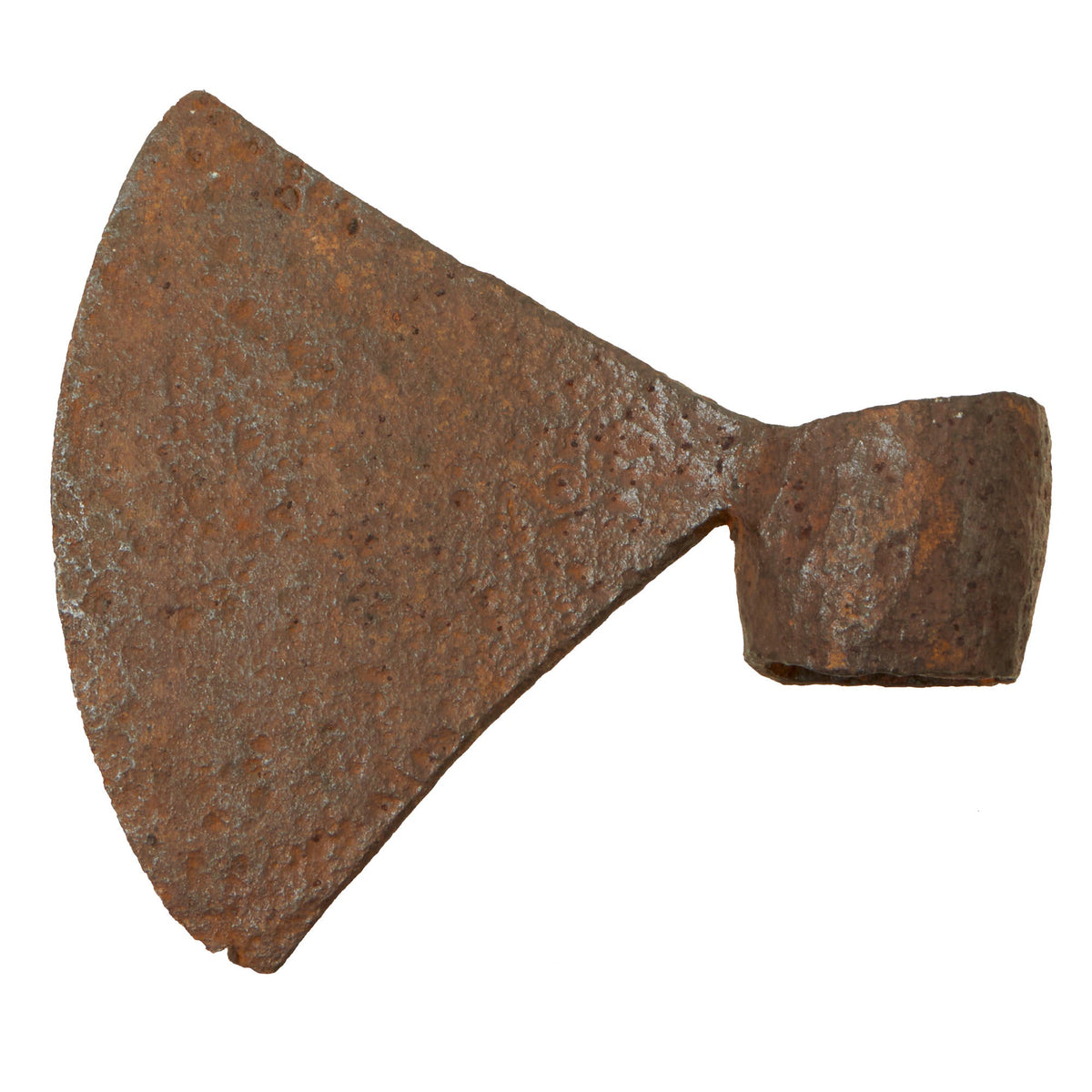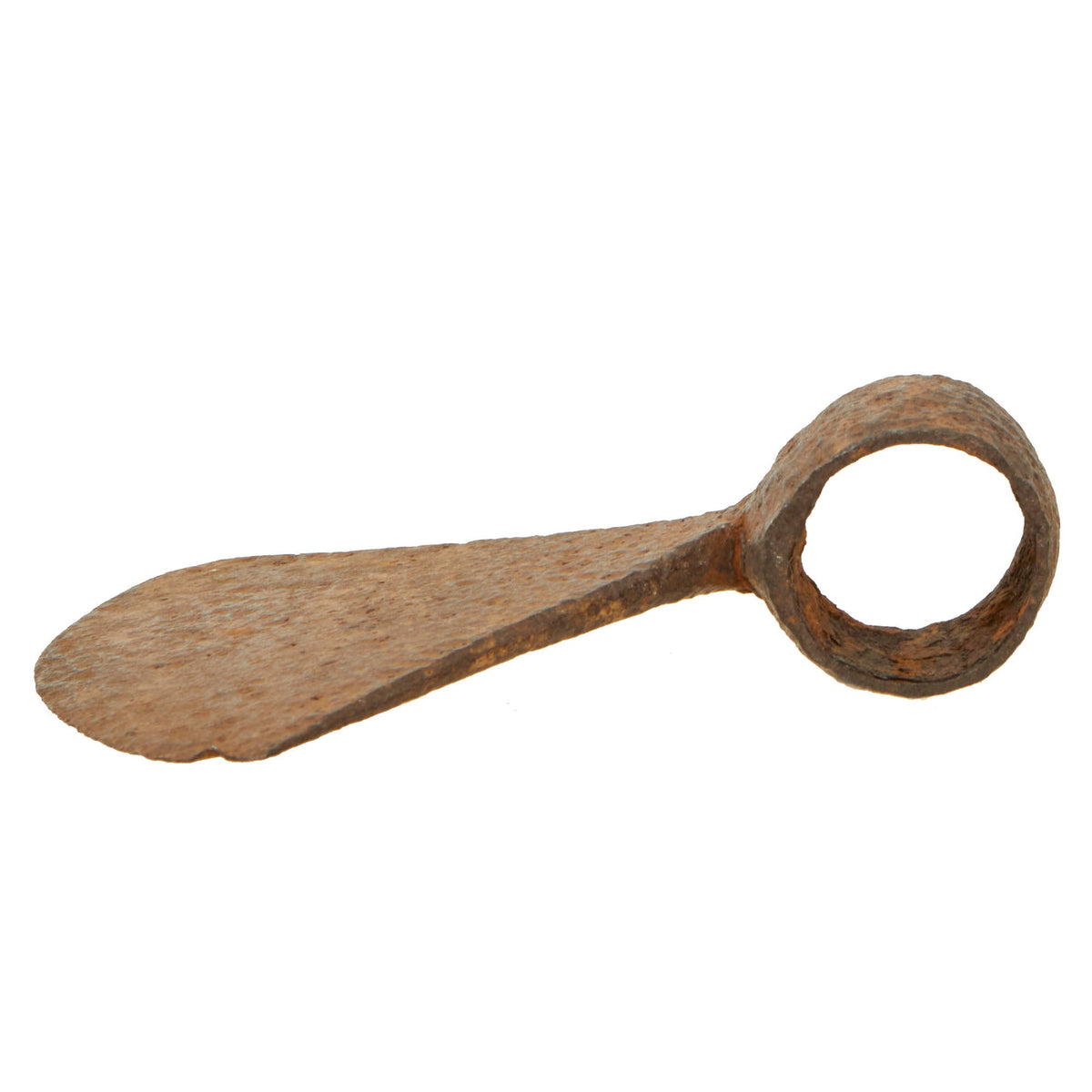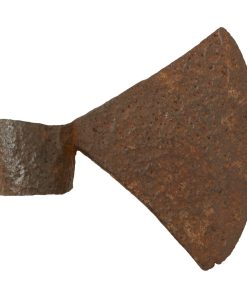Original French Late 17th Century to 18th Century Large Tomahawk Head Excavated At Location of Cherry Valley Massacre In New York Original Items
$ 350,00 $ 105,00
Original Item: Only One Available. This is a fantastic example of an early French tomahawk head dating from the late 17th century to the 18th century. This large tomahawk head was discovered and excavated in Cherry Valley, New York, the same location as the brutal attack made by the British, now known as the Cherry Valley Massacre. This location was also the site of various other attacks, battles, and encampments spanning from the French and Indian War into the American Revolutionary War.
The appearance of the tomahawk head leads us to believe that it was not one of the many “trade tomahawks” produced, but instead could very well have been made specifically as a means of defense for the user. Trade tomahawks generally all carry the same appearance, made from a single piece of iron and then folded to create the well known “teardrop” socket shape.
As the tomahawk head was excavated, there is the expected heavy pitting and oxidation present. It does not appear that any attempts were made to restore or clean it, just the way you like to find them, “as is”. It measures approximately 5 ½” wide with an edge width of 5 inches. There is a rather hard nick in the edge, but it does however appear to have been done in the many years following while spent in the earth.
A great piece of history that comes more than ready for further research and display.
Cherry Valley Massacre
The Cherry Valley massacre was an attack by British and Iroquois forces on a fort and the town of Cherry Valley in central New York on November 11, 1778, during the American Revolutionary War. It has been described as one of the most horrific frontier massacres of the war. A mixed force of Loyalists, British soldiers, Senecas, and Mohawks descended on Cherry Valley, whose defenders, despite warnings, were unprepared for the attack. During the raid, the Seneca in particular targeted non-combatants, and reports state that 30 such individuals were killed, in addition to a number of armed defenders.
The raiders were under the overall command of Walter Butler, who exercised little authority over the Indian warriors on the expedition. Historian Barbara Graymont describes Butler’s command of the expedition as “criminally incompetent”. The Seneca were angered by accusations that they had committed atrocities at the Battle of Wyoming, and the colonists’ recent destruction of their forward bases of operation at Unadilla, Onaquaga, and Tioga. Butler’s authority with the Indigenous People was undermined by his poor treatment of Joseph Brant, the leader of the Mohawks. Butler repeatedly maintained that he was powerless to restrain the Seneca, despite accusations that he permitted the atrocities to take place.
During the campaigns of 1778, Brant achieved an undeserved reputation for brutality. He was not present at Wyoming — although many thought he was — and he along with Captain Jacob (Scott) of the Saponi (Catawba) actively sought to minimize the atrocities that took place at Cherry Valley. Given that Butler was the overall commander of the expedition, there is controversy as to who actually ordered or failed to restrain the killings. The massacre contributed to calls for reprisals, leading to the 1779 Sullivan Expedition which saw the total military defeat of the Iroquois in Upstate New York, who allied with the British.
Fast Shipping with Professional Packaging
Thanks to our longstanding association with UPS FedEx DHL, and other major international carriers, we are able to provide a range of shipping options. Our warehouse staff is expertly trained and will wrap your products according to our exact and precise specifications. Prior to shipping, your goods will be thoroughly examined and securely secured. We ship to thousands clients each day across multiple countries. This shows how we're dedicated to be the largest retailer on the internet. Warehouses and distribution centres can be located throughout Europe as well as the USA.
Note: Orders with more than one item will be assigned a processing date depending on the item.
Before shipping before shipping, we'll conduct a thorough inspection of the items you have ordered. Today, the majority of orders will be delivered within 48 hours. The delivery time will be between 3-7 days.
Returns
The stock is dynamic and we cannot completely manage it because multiple stakeholders are involved, including our factory and warehouse. So the actual stock may alter at any time. It's possible that you may not receive your order once the order has been made.
Our policy is valid for a period of 30 days. If you don't receive the product within 30 days, we are not able to issue a refund or an exchange.
You can only return an item if it is unused and in the same state as the day you received it. You must have the item in its original packaging.
Related products
Uncategorized
Uncategorized
Uncategorized
Uncategorized
Uncategorized
Band of Brothers ORIGINAL GERMAN WWII Le. F.H. 18 10.5cm ARTILLERY PIECE Original Items
Uncategorized
Uncategorized
Uncategorized
Uncategorized
Uncategorized
Uncategorized
Uncategorized
Uncategorized
Uncategorized
Armoured Fighting Vehicles of the World: AFVs of World War One (Hardcover Book) New Made Items
Uncategorized
Uncategorized
Uncategorized
Uncategorized
Australian WWII Owen MK1 Machine Carbine SMG Custom Fabricated Replica with Sling Original Items
Uncategorized










































































